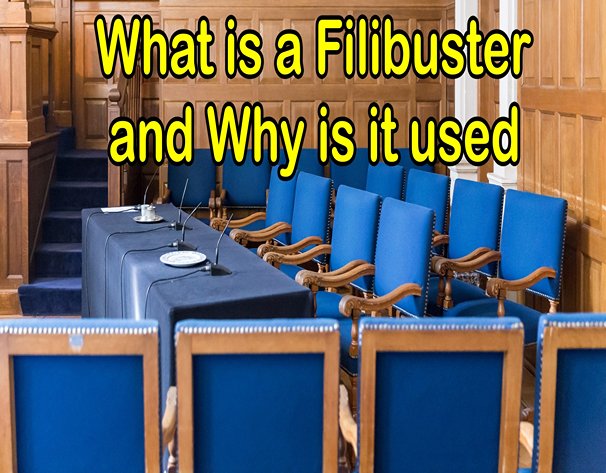Table of Contents
What is a Filibuster and Why is it used
A filibuster is a parliamentary tactic used in some legislative bodies to delay or prevent a vote on a proposed law or measure. This tactic is often employed by the minority party in an effort to block the passage of a bill that they do not support. What is a Filibuster and Why is it used
In the United States Senate, a filibuster occurs when a senator or group of senators speak for an extended period of time in order to delay or prevent a vote on a particular bill or nominee. This can be a lengthy and time-consuming process, as there is no limit to the amount of time a senator can speak on the floor.
The term “filibuster” comes from a Dutch word meaning “pirate,” and it was originally used to describe the efforts of privateers who attempted to delay or obstruct commerce. In the early days of the U.S. Senate, filibusters were used rarely, and usually only by a single senator. However, over time, the use of filibusters has become more common, and the rules have been modified to make it more difficult to end a filibuster.
To filibuster a bill or nominee, a senator will typically speak for as long as possible, sometimes for hours or even days. They may read from books, recite poetry, or simply talk about anything that comes to mind in order to avoid a vote on the bill. In some cases, multiple senators will take turns speaking, tag-teaming to ensure that the filibuster continues without pause.
One of the most famous filibusters in U.S. history occurred in 1957, when Senator Strom Thurmond spoke for over 24 hours in an attempt to block a civil rights bill. More recently, in 2013, Senator Rand Paul spoke for over 13 hours to protest the nomination of John Brennan as CIA Director.
The use of the filibuster has been controversial in recent years, with some arguing that it is an important tool for minority parties to prevent the passage of unpopular legislation, while others believe it is an undemocratic tactic that allows a small minority to block the will of the majority. In response to this debate, some have proposed reforms to the filibuster rules, including the elimination of the filibuster altogether.
A filibuster is a parliamentary tactic used to delay or prevent a vote on a proposed law or measure. While it has a long history in the U.S. Senate and other legislative bodies, it remains a controversial practice that is often the subject of debate and reform efforts.
Why Filibuster is used
The filibuster is a controversial tactic used in legislative bodies to block or delay the passage of a bill. The term filibuster comes from a Dutch word that means “pirate,” and it refers to the act of hijacking a legislative session to prevent a vote on a bill. Although the filibuster is often associated with the United States Senate, it has been used in other parliamentary systems around the world. In this blog post, we will explore the reasons why the filibuster is used.
The primary reason why the filibuster is used is to prevent the passage of a bill that a minority opposes. In a democratic system, the majority has the power to pass legislation, but the minority also has the power to block it. The filibuster allows the minority to exercise this power by preventing a vote on a bill that they believe is harmful to their interests. By speaking for hours or days, a senator or group of senators can delay a vote on a bill, giving the minority more time to rally opposition or negotiate changes to the bill.
Another reason why the filibuster is used is to draw attention to an issue. In some cases, a senator may use a filibuster to draw attention to an issue that they feel is being ignored or overlooked by the majority. By speaking for an extended period of time, a senator can attract media attention and generate public support for their cause. This can be particularly effective for issues that are not well-known or that are controversial.
A third reason why the filibuster is used is to negotiate changes to a bill. When a minority opposes a bill, they may use a filibuster as a bargaining tool to negotiate changes to the bill that would make it more acceptable to them. By delaying a vote on the bill, the minority can force the majority to consider their concerns and negotiate changes that would make the bill more palatable to them.
Despite its effectiveness as a tool for minority parties to block or delay legislation, the filibuster has become increasingly controversial in recent years. Critics argue that the filibuster is undemocratic, as it allows a minority to block the will of the majority. Others argue that the filibuster has been abused, and that it is now being used to block important legislation that would benefit the majority.
The filibuster is used for a variety of reasons, including to block or delay the passage of a bill, to draw attention to an issue, and to negotiate changes to a bill. While it has been an important tool for minority parties to exercise their power, it has also been the subject of controversy and debate. As the political landscape continues to evolve, the future of the filibuster remains uncertain.
Why is it called a filibuster?
The word “filibuster” comes from the Dutch word “vrijbuiter”, which means “pirate” or “freebooter.” The term was first used in the mid-19th century to describe a group of American adventurers who launched unauthorized military expeditions in Latin America. These adventurers were known as “filibusteros,” and their actions were called “filibustering.”
In the mid-1800s, the term was adopted by the U.S. Senate to describe a tactic used by lawmakers to delay or prevent the passage of legislation. At the time, there were no rules in place to limit debate or to force a vote on a bill. Lawmakers could speak for as long as they wanted, and they often did so in an effort to prevent a vote on a bill they opposed.
As the tactic became more common, it came to be known as a “filibuster,” in reference to the actions of the “filibusteros” who had engaged in unauthorized military expeditions. Over time, the term came to be associated specifically with the use of prolonged debate to delay or prevent a vote on a bill.
Today, the term “filibuster” is still used in the U.S. Senate and other legislative bodies to describe a tactic used to delay or prevent a vote on a bill. While the origins of the term are rooted in military history, its current use is primarily political.
What is an example of filibuster?
One famous example of a filibuster in the United States Senate was the 1964 Civil Rights Act filibuster led by Senator Strom Thurmond of South Carolina. The Civil Rights Act aimed to end segregation and discrimination against African Americans, but was strongly opposed by many southern lawmakers who supported racial segregation.
Senator Thurmond began his filibuster by speaking against the bill for 24 hours and 18 minutes, which remains the longest filibuster speech in Senate history. During his speech, he read from the Declaration of Independence, the Bible, and other documents, as well as personal letters and recipes. He also engaged in lengthy digressions and recited historical facts and trivia.
Ultimately, the filibuster was broken when a group of senators from both parties reached a compromise and agreed to limit further debate and proceed to a vote on the bill. The Civil Rights Act was eventually passed and signed into law by President Lyndon B. Johnson.
This example illustrates how a senator or group of senators can use a fili buster to delay or prevent the passage of a bill they strongly oppose, and how it can take an extraordinary effort to break a fili buster and allow a bill to proceed to a vote.













